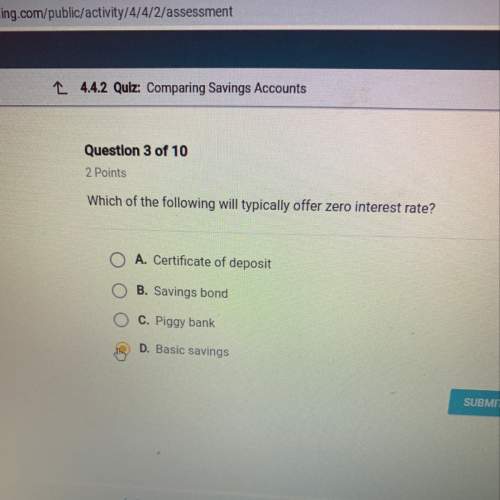
Business, 05.11.2019 06:31 andrejr0330jr
You are considering two equally risky annuities, each of which pays $25,000 per year for 10 years. investment ord is an ordinary (or deferred) annuity, while investment due is an annuity due. which of the following statements is correct? a. if the going rate of interest decreases from 10% to 0%, the difference between the present value of ord and the present value of due would remain constant. b. a rational investor would be willing to pay more for due than for ord, so their market prices should differ. c. the present value of due exceeds the present value of ord, while the future value of due is less than the future value of ord. d. the present value of ord exceeds the present value of due, and the future value of ord also exceeds the future value of due. e. the present value of ord exceeds the present value of due, while the future value of due exceeds the future value of ord.

Answers: 2


Another question on Business

Business, 22.06.2019 11:10
Yowell company granted a sales discount of $360 to a customer when it collected the amount due on account. yowell uses the perpetual inventory system. which of the following answers reflects the effects on the financial statements of only the discount? assets = liab. + equity rev. − exp. = net inc. cash flow a. (360 ) = na + (360 ) (360 ) − na = (360 ) (360 ) oa b. na = (360 ) + 360 360 − na = 360 na c. (360 ) = na + (360 ) (360 ) − na = (360 ) na d. na = (360 ) + 360 360 − na = 360 na
Answers: 1

Business, 22.06.2019 12:30
Suppose that two firms produce differentiated products and compete in prices. as in class, the two firms are located at two ends of a line one mile apart. consumers are evenly distributed along the line. the firms have identical marginal cost, $60. firm b produces a product with value $110 to consumers.firm a (located at 0 on the unit line) produces a higher quality product with value $120 to consumers. the cost of travel are directly related to the distance a consumer travels to purchase a good. if a consumerhas to travel a mile to purchase a good, the incur a cost of $20. if they have to travel x fraction of a mile, they incur a cost of $20x. (a) write down the expressions for how much a consumer at location d would value the products sold by firms a and b, if they set prices p_{a} and p_{b} ? (b) based on your expressions in (a), how much will be demanded from each firm if prices p_{a} and p_{b} are set? (c) what are the nash equilibrium prices?
Answers: 3

Business, 22.06.2019 16:20
The assumptions of the production order quantity model are met in a situation where annual demand is 3650 units, setup cost is $50, holding cost is $12 per unit per year, the daily demand rate is 10 and the daily production rate is 100. the production order quantity for this problem is approximately:
Answers: 1

Business, 22.06.2019 17:40
Croy inc. has the following projected sales for the next five months: month sales in units april 3,850 may 3,875 june 4,260 july 4,135 august 3,590 croy’s finished goods inventory policy is to have 60 percent of the next month’s sales on hand at the end of each month. direct material costs $2.50 per pound, and each unit requires 2 pounds. raw materials inventory policy is to have 50 percent of the next month’s production needs on hand at the end of each month. raw materials on hand at march 31 totaled 3,741 pounds. 1. determine budgeted production for april, may, and june. 2. determine the budgeted cost of materials purchased for april, may, and june. (round your answers to 2 decimal places.)
Answers: 3
You know the right answer?
You are considering two equally risky annuities, each of which pays $25,000 per year for 10 years. i...
Questions


Physics, 08.09.2021 21:20

Mathematics, 08.09.2021 21:20



Biology, 08.09.2021 21:20


Computers and Technology, 08.09.2021 21:20

English, 08.09.2021 21:20


Chemistry, 08.09.2021 21:20

Advanced Placement (AP), 08.09.2021 21:20

Mathematics, 08.09.2021 21:20

English, 08.09.2021 21:20

Mathematics, 08.09.2021 21:20





Mathematics, 08.09.2021 21:20




